In-Depth Business Model Analysis: Domino's Pizza Australia
VerifiedAdded on 2023/06/12
|8
|2796
|239
Essay
AI Summary
This essay provides a comprehensive analysis of Domino's Pizza Australia's business model, exploring its key partners, activities, value propositions, customer relationships, and target segments. It discusses the opportunities and threats faced by the company, including the shift towards health-conscious consumers and fluctuations in share prices. The analysis also delves into Domino's business model as a profit formula, highlighting strategies such as convenient store locations, online ordering systems, diverse product offerings, and a robust operations strategy. Furthermore, the essay examines the company's capabilities and resources, including human resources, financial resources, technological resources, a shared mindset, learning and collaboration, and customer connectivity, all contributing to Domino's success in the fast-food industry. The document is contributed by a student and available on Desklib, a platform offering study tools and resources for students.
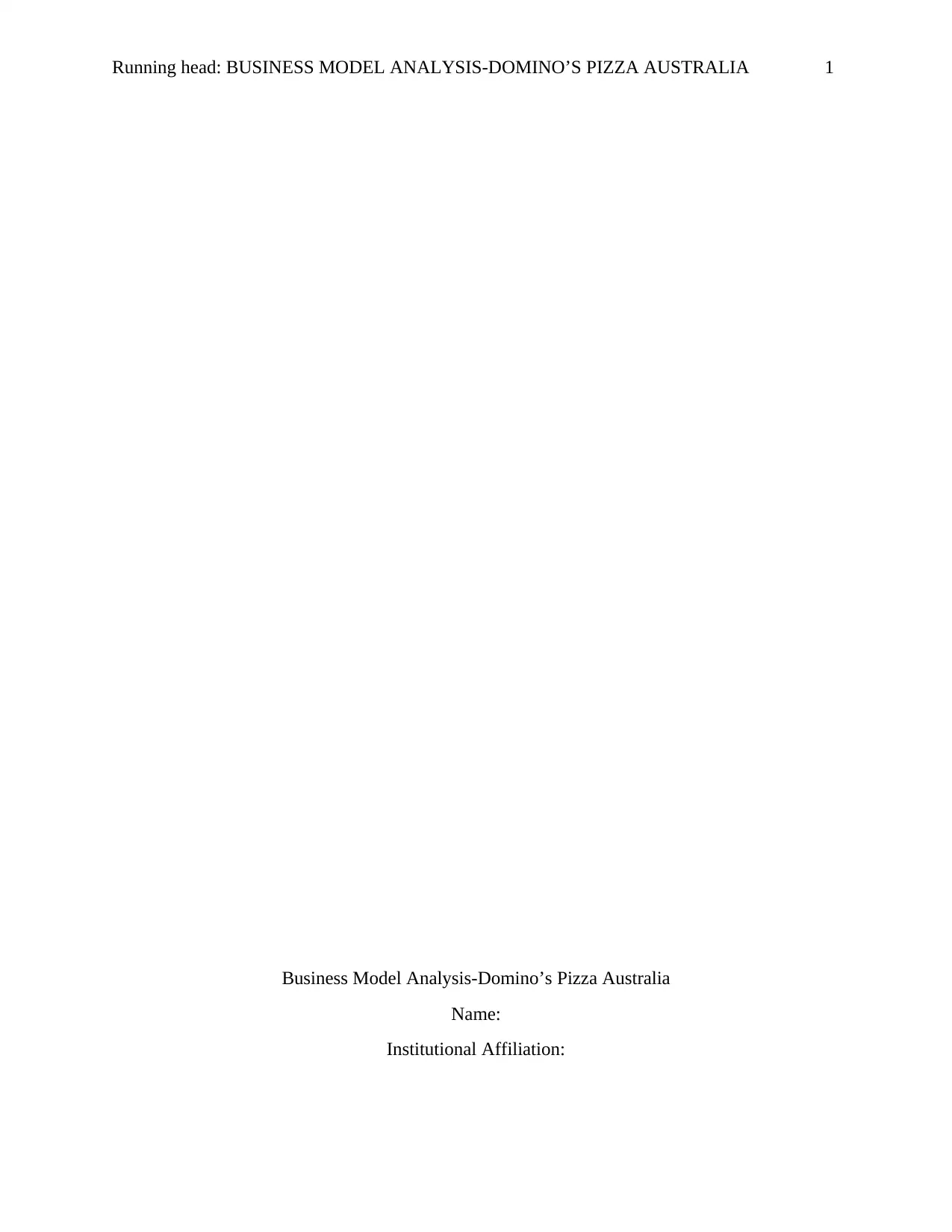
Running head: BUSINESS MODEL ANALYSIS-DOMINO’S PIZZA AUSTRALIA 1
Business Model Analysis-Domino’s Pizza Australia
Name:
Institutional Affiliation:
Business Model Analysis-Domino’s Pizza Australia
Name:
Institutional Affiliation:
Paraphrase This Document
Need a fresh take? Get an instant paraphrase of this document with our AI Paraphraser
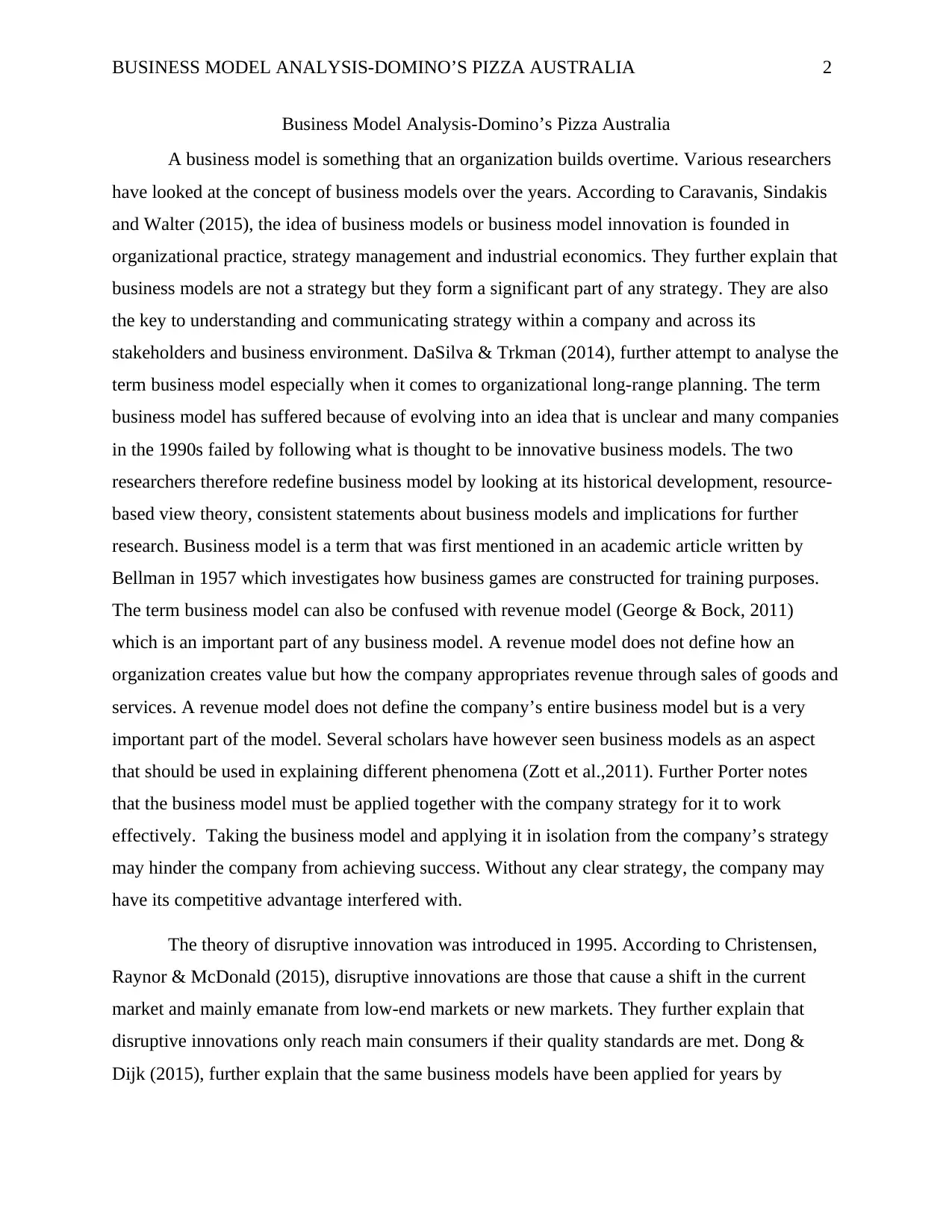
BUSINESS MODEL ANALYSIS-DOMINO’S PIZZA AUSTRALIA 2
Business Model Analysis-Domino’s Pizza Australia
A business model is something that an organization builds overtime. Various researchers
have looked at the concept of business models over the years. According to Caravanis, Sindakis
and Walter (2015), the idea of business models or business model innovation is founded in
organizational practice, strategy management and industrial economics. They further explain that
business models are not a strategy but they form a significant part of any strategy. They are also
the key to understanding and communicating strategy within a company and across its
stakeholders and business environment. DaSilva & Trkman (2014), further attempt to analyse the
term business model especially when it comes to organizational long-range planning. The term
business model has suffered because of evolving into an idea that is unclear and many companies
in the 1990s failed by following what is thought to be innovative business models. The two
researchers therefore redefine business model by looking at its historical development, resource-
based view theory, consistent statements about business models and implications for further
research. Business model is a term that was first mentioned in an academic article written by
Bellman in 1957 which investigates how business games are constructed for training purposes.
The term business model can also be confused with revenue model (George & Bock, 2011)
which is an important part of any business model. A revenue model does not define how an
organization creates value but how the company appropriates revenue through sales of goods and
services. A revenue model does not define the company’s entire business model but is a very
important part of the model. Several scholars have however seen business models as an aspect
that should be used in explaining different phenomena (Zott et al.,2011). Further Porter notes
that the business model must be applied together with the company strategy for it to work
effectively. Taking the business model and applying it in isolation from the company’s strategy
may hinder the company from achieving success. Without any clear strategy, the company may
have its competitive advantage interfered with.
The theory of disruptive innovation was introduced in 1995. According to Christensen,
Raynor & McDonald (2015), disruptive innovations are those that cause a shift in the current
market and mainly emanate from low-end markets or new markets. They further explain that
disruptive innovations only reach main consumers if their quality standards are met. Dong &
Dijk (2015), further explain that the same business models have been applied for years by
Business Model Analysis-Domino’s Pizza Australia
A business model is something that an organization builds overtime. Various researchers
have looked at the concept of business models over the years. According to Caravanis, Sindakis
and Walter (2015), the idea of business models or business model innovation is founded in
organizational practice, strategy management and industrial economics. They further explain that
business models are not a strategy but they form a significant part of any strategy. They are also
the key to understanding and communicating strategy within a company and across its
stakeholders and business environment. DaSilva & Trkman (2014), further attempt to analyse the
term business model especially when it comes to organizational long-range planning. The term
business model has suffered because of evolving into an idea that is unclear and many companies
in the 1990s failed by following what is thought to be innovative business models. The two
researchers therefore redefine business model by looking at its historical development, resource-
based view theory, consistent statements about business models and implications for further
research. Business model is a term that was first mentioned in an academic article written by
Bellman in 1957 which investigates how business games are constructed for training purposes.
The term business model can also be confused with revenue model (George & Bock, 2011)
which is an important part of any business model. A revenue model does not define how an
organization creates value but how the company appropriates revenue through sales of goods and
services. A revenue model does not define the company’s entire business model but is a very
important part of the model. Several scholars have however seen business models as an aspect
that should be used in explaining different phenomena (Zott et al.,2011). Further Porter notes
that the business model must be applied together with the company strategy for it to work
effectively. Taking the business model and applying it in isolation from the company’s strategy
may hinder the company from achieving success. Without any clear strategy, the company may
have its competitive advantage interfered with.
The theory of disruptive innovation was introduced in 1995. According to Christensen,
Raynor & McDonald (2015), disruptive innovations are those that cause a shift in the current
market and mainly emanate from low-end markets or new markets. They further explain that
disruptive innovations only reach main consumers if their quality standards are met. Dong &
Dijk (2015), further explain that the same business models have been applied for years by
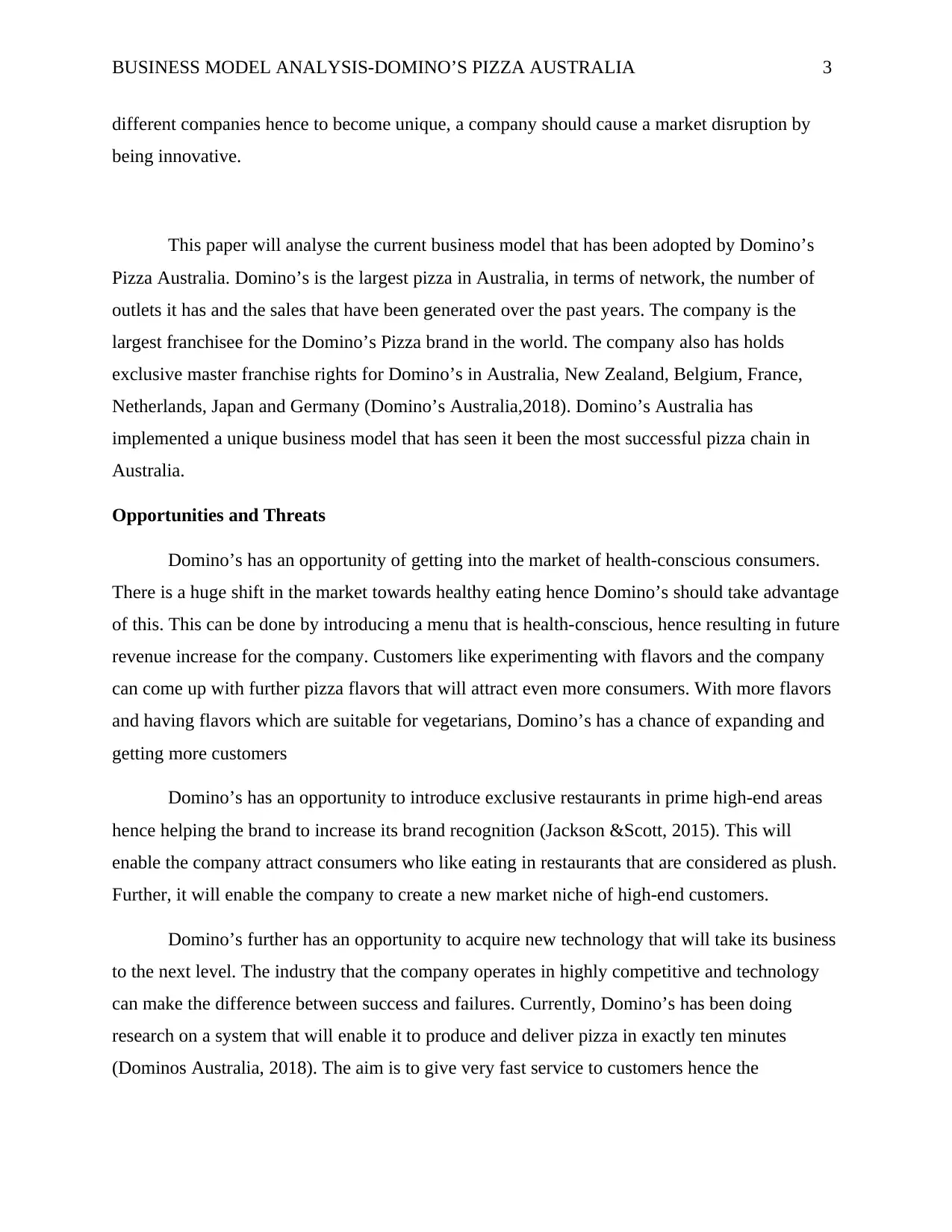
BUSINESS MODEL ANALYSIS-DOMINO’S PIZZA AUSTRALIA 3
different companies hence to become unique, a company should cause a market disruption by
being innovative.
This paper will analyse the current business model that has been adopted by Domino’s
Pizza Australia. Domino’s is the largest pizza in Australia, in terms of network, the number of
outlets it has and the sales that have been generated over the past years. The company is the
largest franchisee for the Domino’s Pizza brand in the world. The company also has holds
exclusive master franchise rights for Domino’s in Australia, New Zealand, Belgium, France,
Netherlands, Japan and Germany (Domino’s Australia,2018). Domino’s Australia has
implemented a unique business model that has seen it been the most successful pizza chain in
Australia.
Opportunities and Threats
Domino’s has an opportunity of getting into the market of health-conscious consumers.
There is a huge shift in the market towards healthy eating hence Domino’s should take advantage
of this. This can be done by introducing a menu that is health-conscious, hence resulting in future
revenue increase for the company. Customers like experimenting with flavors and the company
can come up with further pizza flavors that will attract even more consumers. With more flavors
and having flavors which are suitable for vegetarians, Domino’s has a chance of expanding and
getting more customers
Domino’s has an opportunity to introduce exclusive restaurants in prime high-end areas
hence helping the brand to increase its brand recognition (Jackson &Scott, 2015). This will
enable the company attract consumers who like eating in restaurants that are considered as plush.
Further, it will enable the company to create a new market niche of high-end customers.
Domino’s further has an opportunity to acquire new technology that will take its business
to the next level. The industry that the company operates in highly competitive and technology
can make the difference between success and failures. Currently, Domino’s has been doing
research on a system that will enable it to produce and deliver pizza in exactly ten minutes
(Dominos Australia, 2018). The aim is to give very fast service to customers hence the
different companies hence to become unique, a company should cause a market disruption by
being innovative.
This paper will analyse the current business model that has been adopted by Domino’s
Pizza Australia. Domino’s is the largest pizza in Australia, in terms of network, the number of
outlets it has and the sales that have been generated over the past years. The company is the
largest franchisee for the Domino’s Pizza brand in the world. The company also has holds
exclusive master franchise rights for Domino’s in Australia, New Zealand, Belgium, France,
Netherlands, Japan and Germany (Domino’s Australia,2018). Domino’s Australia has
implemented a unique business model that has seen it been the most successful pizza chain in
Australia.
Opportunities and Threats
Domino’s has an opportunity of getting into the market of health-conscious consumers.
There is a huge shift in the market towards healthy eating hence Domino’s should take advantage
of this. This can be done by introducing a menu that is health-conscious, hence resulting in future
revenue increase for the company. Customers like experimenting with flavors and the company
can come up with further pizza flavors that will attract even more consumers. With more flavors
and having flavors which are suitable for vegetarians, Domino’s has a chance of expanding and
getting more customers
Domino’s has an opportunity to introduce exclusive restaurants in prime high-end areas
hence helping the brand to increase its brand recognition (Jackson &Scott, 2015). This will
enable the company attract consumers who like eating in restaurants that are considered as plush.
Further, it will enable the company to create a new market niche of high-end customers.
Domino’s further has an opportunity to acquire new technology that will take its business
to the next level. The industry that the company operates in highly competitive and technology
can make the difference between success and failures. Currently, Domino’s has been doing
research on a system that will enable it to produce and deliver pizza in exactly ten minutes
(Dominos Australia, 2018). The aim is to give very fast service to customers hence the
⊘ This is a preview!⊘
Do you want full access?
Subscribe today to unlock all pages.

Trusted by 1+ million students worldwide
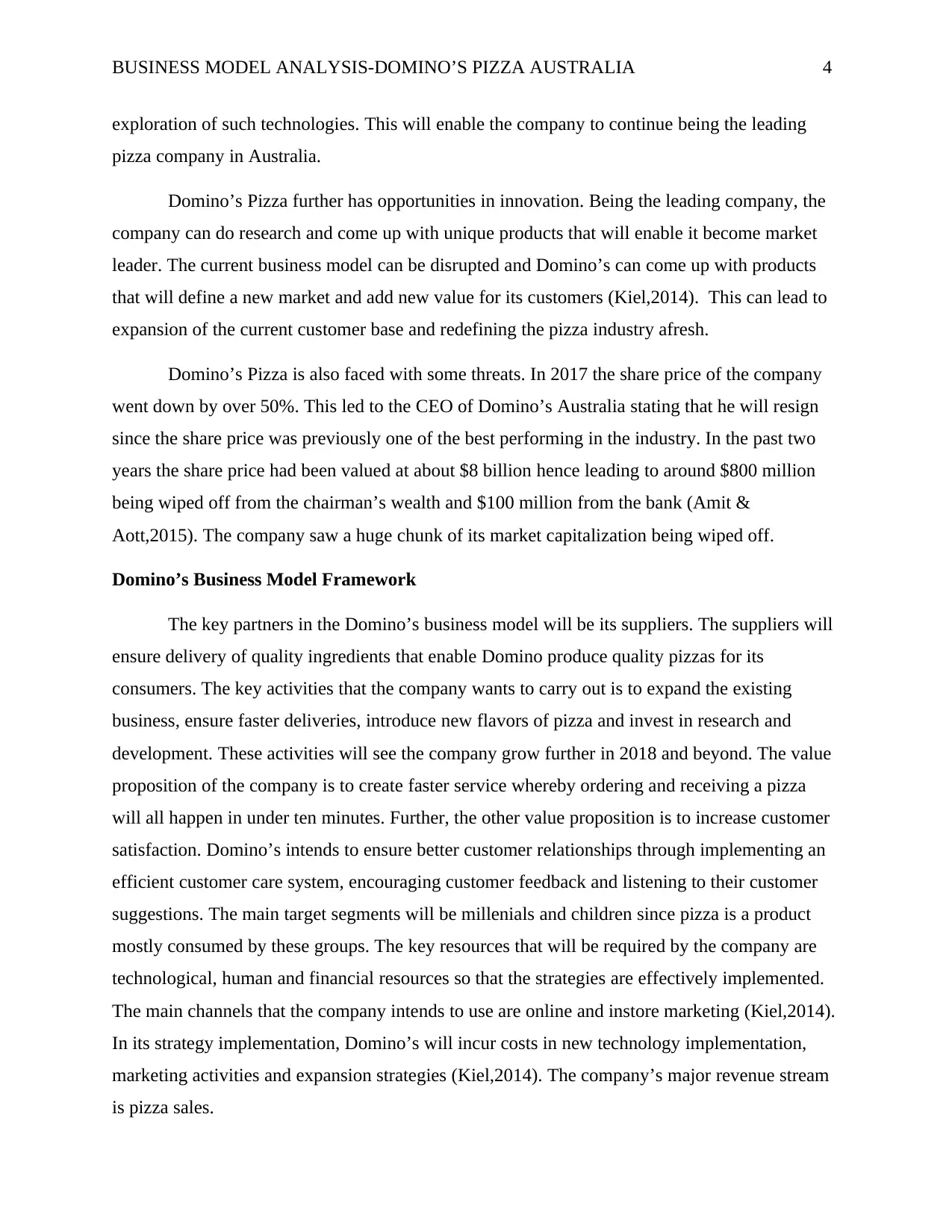
BUSINESS MODEL ANALYSIS-DOMINO’S PIZZA AUSTRALIA 4
exploration of such technologies. This will enable the company to continue being the leading
pizza company in Australia.
Domino’s Pizza further has opportunities in innovation. Being the leading company, the
company can do research and come up with unique products that will enable it become market
leader. The current business model can be disrupted and Domino’s can come up with products
that will define a new market and add new value for its customers (Kiel,2014). This can lead to
expansion of the current customer base and redefining the pizza industry afresh.
Domino’s Pizza is also faced with some threats. In 2017 the share price of the company
went down by over 50%. This led to the CEO of Domino’s Australia stating that he will resign
since the share price was previously one of the best performing in the industry. In the past two
years the share price had been valued at about $8 billion hence leading to around $800 million
being wiped off from the chairman’s wealth and $100 million from the bank (Amit &
Aott,2015). The company saw a huge chunk of its market capitalization being wiped off.
Domino’s Business Model Framework
The key partners in the Domino’s business model will be its suppliers. The suppliers will
ensure delivery of quality ingredients that enable Domino produce quality pizzas for its
consumers. The key activities that the company wants to carry out is to expand the existing
business, ensure faster deliveries, introduce new flavors of pizza and invest in research and
development. These activities will see the company grow further in 2018 and beyond. The value
proposition of the company is to create faster service whereby ordering and receiving a pizza
will all happen in under ten minutes. Further, the other value proposition is to increase customer
satisfaction. Domino’s intends to ensure better customer relationships through implementing an
efficient customer care system, encouraging customer feedback and listening to their customer
suggestions. The main target segments will be millenials and children since pizza is a product
mostly consumed by these groups. The key resources that will be required by the company are
technological, human and financial resources so that the strategies are effectively implemented.
The main channels that the company intends to use are online and instore marketing (Kiel,2014).
In its strategy implementation, Domino’s will incur costs in new technology implementation,
marketing activities and expansion strategies (Kiel,2014). The company’s major revenue stream
is pizza sales.
exploration of such technologies. This will enable the company to continue being the leading
pizza company in Australia.
Domino’s Pizza further has opportunities in innovation. Being the leading company, the
company can do research and come up with unique products that will enable it become market
leader. The current business model can be disrupted and Domino’s can come up with products
that will define a new market and add new value for its customers (Kiel,2014). This can lead to
expansion of the current customer base and redefining the pizza industry afresh.
Domino’s Pizza is also faced with some threats. In 2017 the share price of the company
went down by over 50%. This led to the CEO of Domino’s Australia stating that he will resign
since the share price was previously one of the best performing in the industry. In the past two
years the share price had been valued at about $8 billion hence leading to around $800 million
being wiped off from the chairman’s wealth and $100 million from the bank (Amit &
Aott,2015). The company saw a huge chunk of its market capitalization being wiped off.
Domino’s Business Model Framework
The key partners in the Domino’s business model will be its suppliers. The suppliers will
ensure delivery of quality ingredients that enable Domino produce quality pizzas for its
consumers. The key activities that the company wants to carry out is to expand the existing
business, ensure faster deliveries, introduce new flavors of pizza and invest in research and
development. These activities will see the company grow further in 2018 and beyond. The value
proposition of the company is to create faster service whereby ordering and receiving a pizza
will all happen in under ten minutes. Further, the other value proposition is to increase customer
satisfaction. Domino’s intends to ensure better customer relationships through implementing an
efficient customer care system, encouraging customer feedback and listening to their customer
suggestions. The main target segments will be millenials and children since pizza is a product
mostly consumed by these groups. The key resources that will be required by the company are
technological, human and financial resources so that the strategies are effectively implemented.
The main channels that the company intends to use are online and instore marketing (Kiel,2014).
In its strategy implementation, Domino’s will incur costs in new technology implementation,
marketing activities and expansion strategies (Kiel,2014). The company’s major revenue stream
is pizza sales.
Paraphrase This Document
Need a fresh take? Get an instant paraphrase of this document with our AI Paraphraser
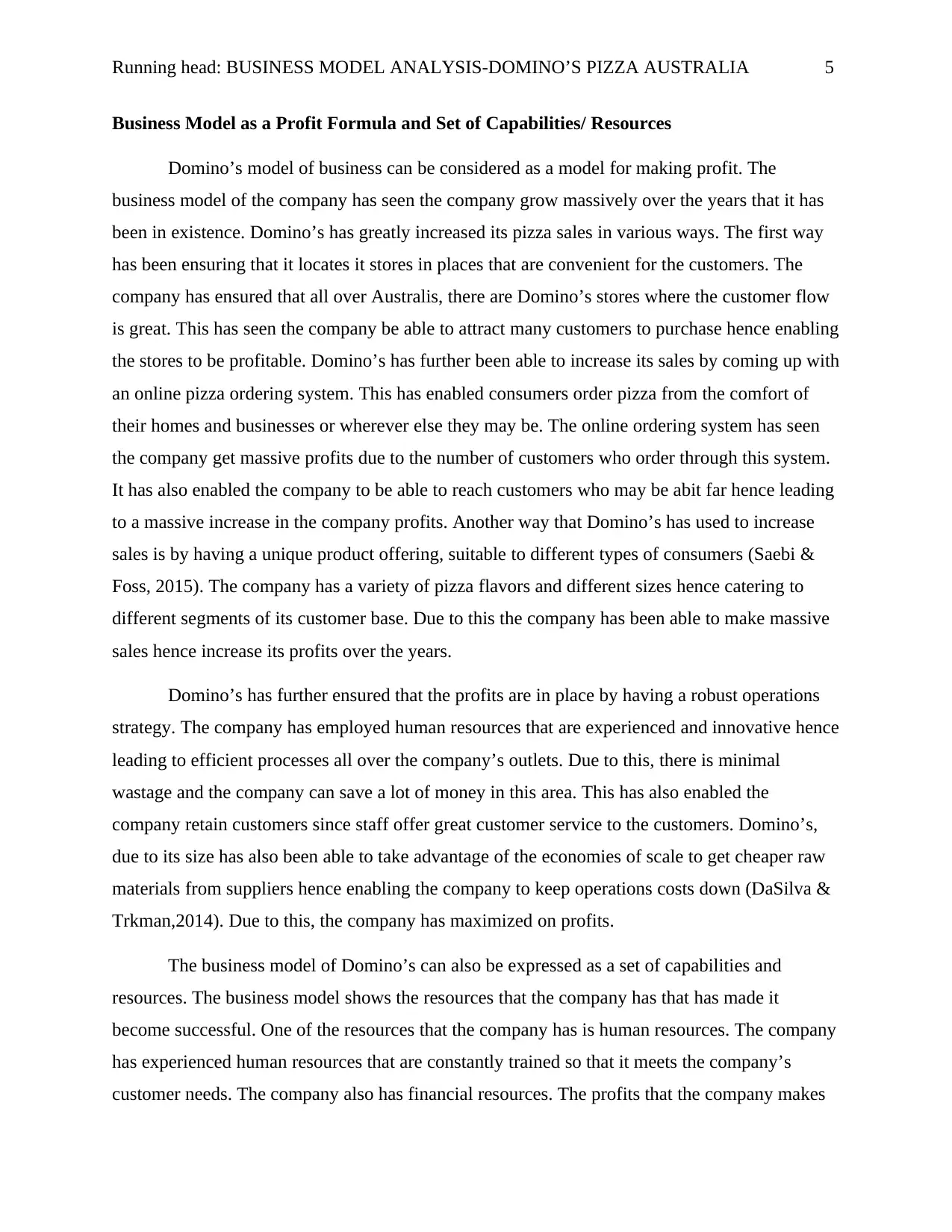
Running head: BUSINESS MODEL ANALYSIS-DOMINO’S PIZZA AUSTRALIA 5
Business Model as a Profit Formula and Set of Capabilities/ Resources
Domino’s model of business can be considered as a model for making profit. The
business model of the company has seen the company grow massively over the years that it has
been in existence. Domino’s has greatly increased its pizza sales in various ways. The first way
has been ensuring that it locates it stores in places that are convenient for the customers. The
company has ensured that all over Australis, there are Domino’s stores where the customer flow
is great. This has seen the company be able to attract many customers to purchase hence enabling
the stores to be profitable. Domino’s has further been able to increase its sales by coming up with
an online pizza ordering system. This has enabled consumers order pizza from the comfort of
their homes and businesses or wherever else they may be. The online ordering system has seen
the company get massive profits due to the number of customers who order through this system.
It has also enabled the company to be able to reach customers who may be abit far hence leading
to a massive increase in the company profits. Another way that Domino’s has used to increase
sales is by having a unique product offering, suitable to different types of consumers (Saebi &
Foss, 2015). The company has a variety of pizza flavors and different sizes hence catering to
different segments of its customer base. Due to this the company has been able to make massive
sales hence increase its profits over the years.
Domino’s has further ensured that the profits are in place by having a robust operations
strategy. The company has employed human resources that are experienced and innovative hence
leading to efficient processes all over the company’s outlets. Due to this, there is minimal
wastage and the company can save a lot of money in this area. This has also enabled the
company retain customers since staff offer great customer service to the customers. Domino’s,
due to its size has also been able to take advantage of the economies of scale to get cheaper raw
materials from suppliers hence enabling the company to keep operations costs down (DaSilva &
Trkman,2014). Due to this, the company has maximized on profits.
The business model of Domino’s can also be expressed as a set of capabilities and
resources. The business model shows the resources that the company has that has made it
become successful. One of the resources that the company has is human resources. The company
has experienced human resources that are constantly trained so that it meets the company’s
customer needs. The company also has financial resources. The profits that the company makes
Business Model as a Profit Formula and Set of Capabilities/ Resources
Domino’s model of business can be considered as a model for making profit. The
business model of the company has seen the company grow massively over the years that it has
been in existence. Domino’s has greatly increased its pizza sales in various ways. The first way
has been ensuring that it locates it stores in places that are convenient for the customers. The
company has ensured that all over Australis, there are Domino’s stores where the customer flow
is great. This has seen the company be able to attract many customers to purchase hence enabling
the stores to be profitable. Domino’s has further been able to increase its sales by coming up with
an online pizza ordering system. This has enabled consumers order pizza from the comfort of
their homes and businesses or wherever else they may be. The online ordering system has seen
the company get massive profits due to the number of customers who order through this system.
It has also enabled the company to be able to reach customers who may be abit far hence leading
to a massive increase in the company profits. Another way that Domino’s has used to increase
sales is by having a unique product offering, suitable to different types of consumers (Saebi &
Foss, 2015). The company has a variety of pizza flavors and different sizes hence catering to
different segments of its customer base. Due to this the company has been able to make massive
sales hence increase its profits over the years.
Domino’s has further ensured that the profits are in place by having a robust operations
strategy. The company has employed human resources that are experienced and innovative hence
leading to efficient processes all over the company’s outlets. Due to this, there is minimal
wastage and the company can save a lot of money in this area. This has also enabled the
company retain customers since staff offer great customer service to the customers. Domino’s,
due to its size has also been able to take advantage of the economies of scale to get cheaper raw
materials from suppliers hence enabling the company to keep operations costs down (DaSilva &
Trkman,2014). Due to this, the company has maximized on profits.
The business model of Domino’s can also be expressed as a set of capabilities and
resources. The business model shows the resources that the company has that has made it
become successful. One of the resources that the company has is human resources. The company
has experienced human resources that are constantly trained so that it meets the company’s
customer needs. The company also has financial resources. The profits that the company makes
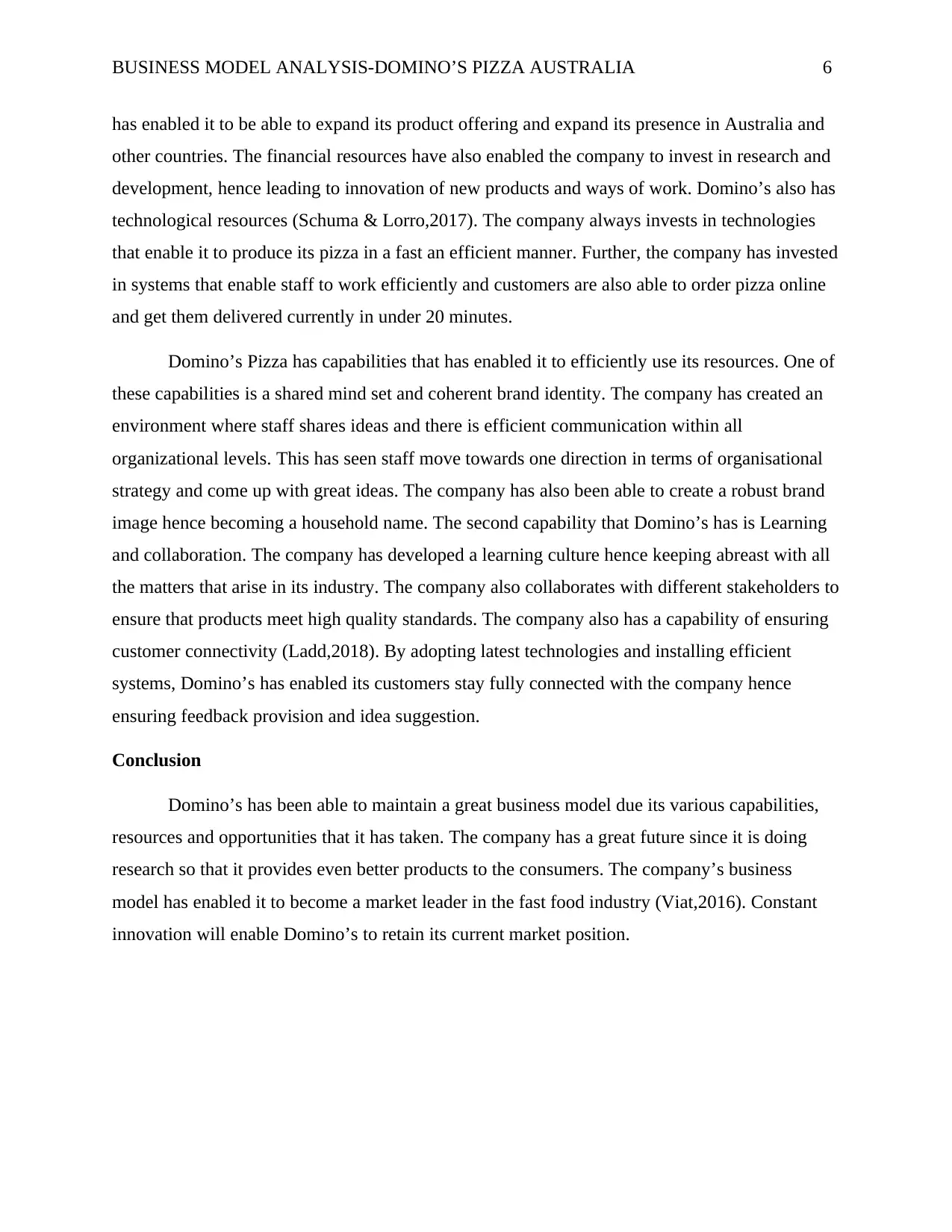
BUSINESS MODEL ANALYSIS-DOMINO’S PIZZA AUSTRALIA 6
has enabled it to be able to expand its product offering and expand its presence in Australia and
other countries. The financial resources have also enabled the company to invest in research and
development, hence leading to innovation of new products and ways of work. Domino’s also has
technological resources (Schuma & Lorro,2017). The company always invests in technologies
that enable it to produce its pizza in a fast an efficient manner. Further, the company has invested
in systems that enable staff to work efficiently and customers are also able to order pizza online
and get them delivered currently in under 20 minutes.
Domino’s Pizza has capabilities that has enabled it to efficiently use its resources. One of
these capabilities is a shared mind set and coherent brand identity. The company has created an
environment where staff shares ideas and there is efficient communication within all
organizational levels. This has seen staff move towards one direction in terms of organisational
strategy and come up with great ideas. The company has also been able to create a robust brand
image hence becoming a household name. The second capability that Domino’s has is Learning
and collaboration. The company has developed a learning culture hence keeping abreast with all
the matters that arise in its industry. The company also collaborates with different stakeholders to
ensure that products meet high quality standards. The company also has a capability of ensuring
customer connectivity (Ladd,2018). By adopting latest technologies and installing efficient
systems, Domino’s has enabled its customers stay fully connected with the company hence
ensuring feedback provision and idea suggestion.
Conclusion
Domino’s has been able to maintain a great business model due its various capabilities,
resources and opportunities that it has taken. The company has a great future since it is doing
research so that it provides even better products to the consumers. The company’s business
model has enabled it to become a market leader in the fast food industry (Viat,2016). Constant
innovation will enable Domino’s to retain its current market position.
has enabled it to be able to expand its product offering and expand its presence in Australia and
other countries. The financial resources have also enabled the company to invest in research and
development, hence leading to innovation of new products and ways of work. Domino’s also has
technological resources (Schuma & Lorro,2017). The company always invests in technologies
that enable it to produce its pizza in a fast an efficient manner. Further, the company has invested
in systems that enable staff to work efficiently and customers are also able to order pizza online
and get them delivered currently in under 20 minutes.
Domino’s Pizza has capabilities that has enabled it to efficiently use its resources. One of
these capabilities is a shared mind set and coherent brand identity. The company has created an
environment where staff shares ideas and there is efficient communication within all
organizational levels. This has seen staff move towards one direction in terms of organisational
strategy and come up with great ideas. The company has also been able to create a robust brand
image hence becoming a household name. The second capability that Domino’s has is Learning
and collaboration. The company has developed a learning culture hence keeping abreast with all
the matters that arise in its industry. The company also collaborates with different stakeholders to
ensure that products meet high quality standards. The company also has a capability of ensuring
customer connectivity (Ladd,2018). By adopting latest technologies and installing efficient
systems, Domino’s has enabled its customers stay fully connected with the company hence
ensuring feedback provision and idea suggestion.
Conclusion
Domino’s has been able to maintain a great business model due its various capabilities,
resources and opportunities that it has taken. The company has a great future since it is doing
research so that it provides even better products to the consumers. The company’s business
model has enabled it to become a market leader in the fast food industry (Viat,2016). Constant
innovation will enable Domino’s to retain its current market position.
⊘ This is a preview!⊘
Do you want full access?
Subscribe today to unlock all pages.

Trusted by 1+ million students worldwide
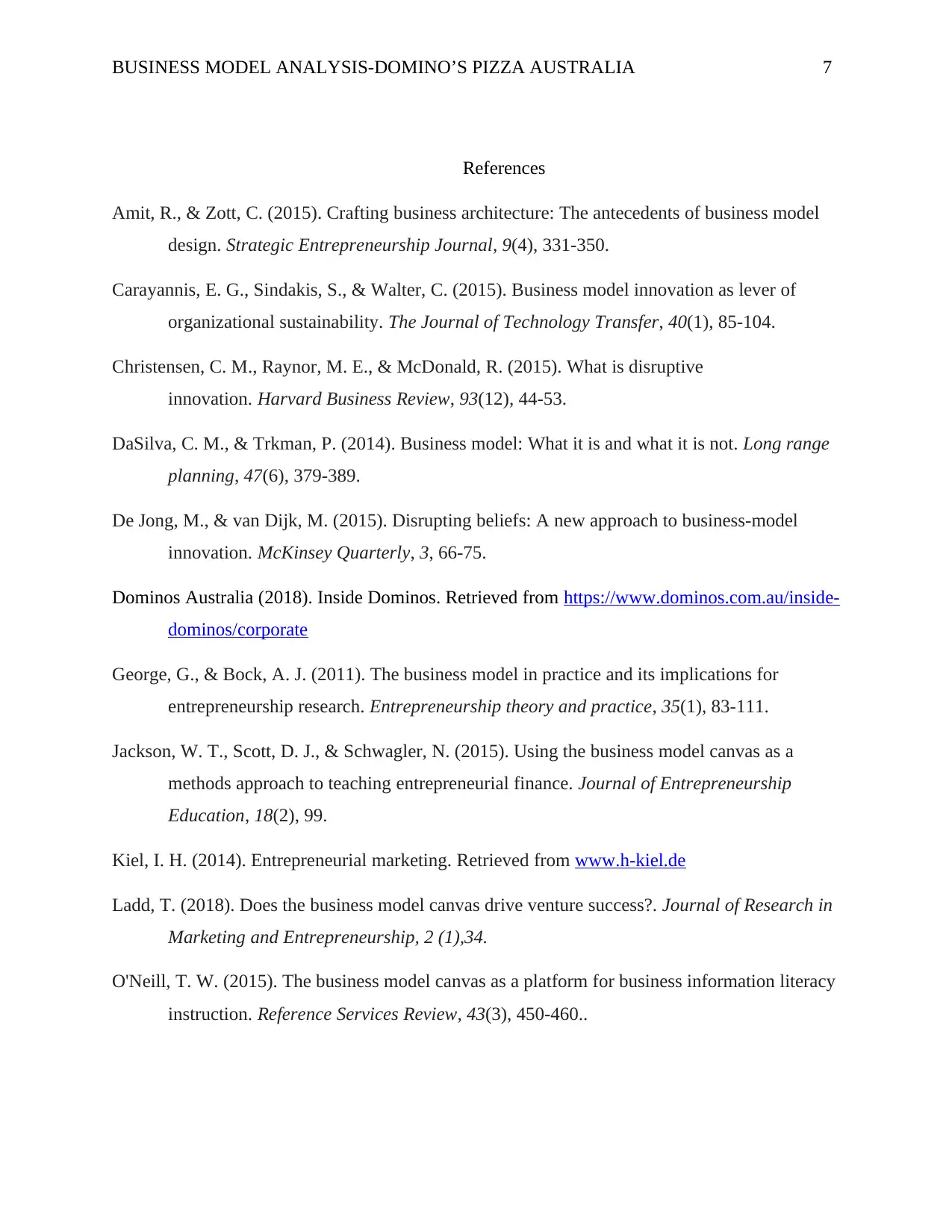
BUSINESS MODEL ANALYSIS-DOMINO’S PIZZA AUSTRALIA 7
References
Amit, R., & Zott, C. (2015). Crafting business architecture: The antecedents of business model
design. Strategic Entrepreneurship Journal, 9(4), 331-350.
Carayannis, E. G., Sindakis, S., & Walter, C. (2015). Business model innovation as lever of
organizational sustainability. The Journal of Technology Transfer, 40(1), 85-104.
Christensen, C. M., Raynor, M. E., & McDonald, R. (2015). What is disruptive
innovation. Harvard Business Review, 93(12), 44-53.
DaSilva, C. M., & Trkman, P. (2014). Business model: What it is and what it is not. Long range
planning, 47(6), 379-389.
De Jong, M., & van Dijk, M. (2015). Disrupting beliefs: A new approach to business-model
innovation. McKinsey Quarterly, 3, 66-75.
Dominos Australia (2018). Inside Dominos. Retrieved from https://www.dominos.com.au/inside-
dominos/corporate
George, G., & Bock, A. J. (2011). The business model in practice and its implications for
entrepreneurship research. Entrepreneurship theory and practice, 35(1), 83-111.
Jackson, W. T., Scott, D. J., & Schwagler, N. (2015). Using the business model canvas as a
methods approach to teaching entrepreneurial finance. Journal of Entrepreneurship
Education, 18(2), 99.
Kiel, I. H. (2014). Entrepreneurial marketing. Retrieved from www.h-kiel.de
Ladd, T. (2018). Does the business model canvas drive venture success?. Journal of Research in
Marketing and Entrepreneurship, 2 (1),34.
O'Neill, T. W. (2015). The business model canvas as a platform for business information literacy
instruction. Reference Services Review, 43(3), 450-460..
References
Amit, R., & Zott, C. (2015). Crafting business architecture: The antecedents of business model
design. Strategic Entrepreneurship Journal, 9(4), 331-350.
Carayannis, E. G., Sindakis, S., & Walter, C. (2015). Business model innovation as lever of
organizational sustainability. The Journal of Technology Transfer, 40(1), 85-104.
Christensen, C. M., Raynor, M. E., & McDonald, R. (2015). What is disruptive
innovation. Harvard Business Review, 93(12), 44-53.
DaSilva, C. M., & Trkman, P. (2014). Business model: What it is and what it is not. Long range
planning, 47(6), 379-389.
De Jong, M., & van Dijk, M. (2015). Disrupting beliefs: A new approach to business-model
innovation. McKinsey Quarterly, 3, 66-75.
Dominos Australia (2018). Inside Dominos. Retrieved from https://www.dominos.com.au/inside-
dominos/corporate
George, G., & Bock, A. J. (2011). The business model in practice and its implications for
entrepreneurship research. Entrepreneurship theory and practice, 35(1), 83-111.
Jackson, W. T., Scott, D. J., & Schwagler, N. (2015). Using the business model canvas as a
methods approach to teaching entrepreneurial finance. Journal of Entrepreneurship
Education, 18(2), 99.
Kiel, I. H. (2014). Entrepreneurial marketing. Retrieved from www.h-kiel.de
Ladd, T. (2018). Does the business model canvas drive venture success?. Journal of Research in
Marketing and Entrepreneurship, 2 (1),34.
O'Neill, T. W. (2015). The business model canvas as a platform for business information literacy
instruction. Reference Services Review, 43(3), 450-460..
Paraphrase This Document
Need a fresh take? Get an instant paraphrase of this document with our AI Paraphraser
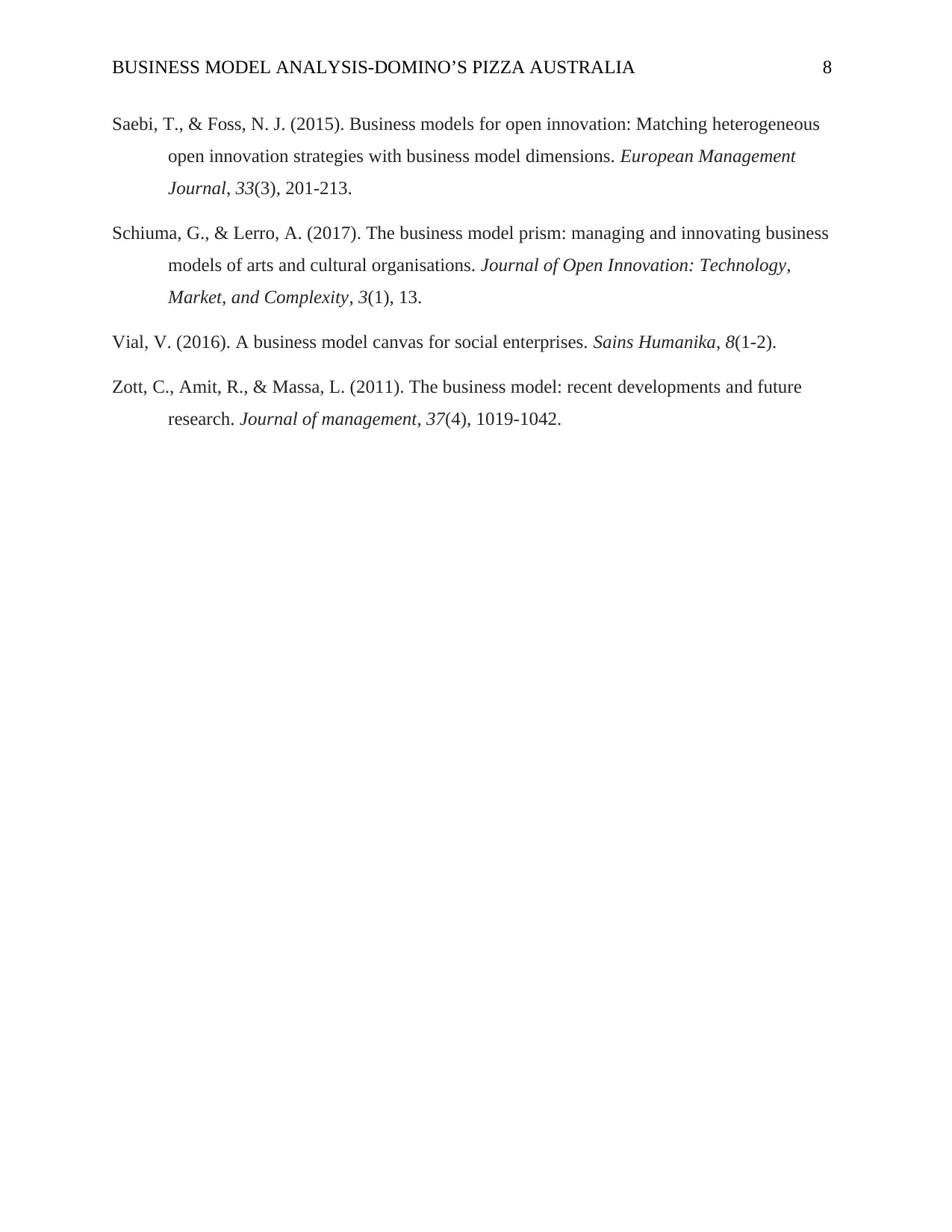
BUSINESS MODEL ANALYSIS-DOMINO’S PIZZA AUSTRALIA 8
Saebi, T., & Foss, N. J. (2015). Business models for open innovation: Matching heterogeneous
open innovation strategies with business model dimensions. European Management
Journal, 33(3), 201-213.
Schiuma, G., & Lerro, A. (2017). The business model prism: managing and innovating business
models of arts and cultural organisations. Journal of Open Innovation: Technology,
Market, and Complexity, 3(1), 13.
Vial, V. (2016). A business model canvas for social enterprises. Sains Humanika, 8(1-2).
Zott, C., Amit, R., & Massa, L. (2011). The business model: recent developments and future
research. Journal of management, 37(4), 1019-1042.
Saebi, T., & Foss, N. J. (2015). Business models for open innovation: Matching heterogeneous
open innovation strategies with business model dimensions. European Management
Journal, 33(3), 201-213.
Schiuma, G., & Lerro, A. (2017). The business model prism: managing and innovating business
models of arts and cultural organisations. Journal of Open Innovation: Technology,
Market, and Complexity, 3(1), 13.
Vial, V. (2016). A business model canvas for social enterprises. Sains Humanika, 8(1-2).
Zott, C., Amit, R., & Massa, L. (2011). The business model: recent developments and future
research. Journal of management, 37(4), 1019-1042.
1 out of 8
Related Documents
Your All-in-One AI-Powered Toolkit for Academic Success.
+13062052269
info@desklib.com
Available 24*7 on WhatsApp / Email
![[object Object]](/_next/static/media/star-bottom.7253800d.svg)
Unlock your academic potential
Copyright © 2020–2025 A2Z Services. All Rights Reserved. Developed and managed by ZUCOL.


